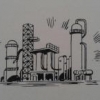Latest Downloads
-
 Water Bath Indirect Heaters
Water Bath Indirect HeatersArt Montemayor - Oct 12 2018 02:35 PM
-
 Petroleum: A Primer for Kansas
Petroleum: A Primer for KansasArt Montemayor - Oct 12 2018 02:27 PM
-
 Spray Tower for Flue Gas Scrubbing Design
Spray Tower for Flue Gas Scrubbing Designankur2061 - May 02 2018 02:31 PM
-
 Selection of Vertical Tanks
Selection of Vertical Tanksankur2061 - Apr 19 2018 07:42 AM
-
 Pressure Drop Calculator for Strainers 1
Pressure Drop Calculator for Strainers 1ankur2061 - Mar 24 2017 02:04 PM
-
 Horizontal Pig Trap System Design Guidelines
Horizontal Pig Trap System Design Guidelinesankur2061 - Jan 14 2017 02:54 PM
-
 Performance Prediction of 3-Stage Propane Refrigeration System
Performance Prediction of 3-Stage Propane Refrigeration Systemankur2061 - Aug 08 2016 02:43 PM
-
 Centrifugal Pump Troubleshooting Checklist
Centrifugal Pump Troubleshooting Checklistankur2061 - Dec 17 2015 08:18 AM
-
 Compressor Troubleshooting Checklist
Compressor Troubleshooting Checklistankur2061 - Sep 08 2015 11:43 AM
-
 Amine Sweetening Unit Preliminary Design
Amine Sweetening Unit Preliminary Designankur2061 - May 19 2015 09:35 AM
Popular Store Titles
 Tank Jacket Calculator
Tank Jacket Calculator
 Specification Sheet Collection
Specification Sheet Collection
 PIPESIZE
PIPESIZE
 Relief Valve Sizing
Relief Valve Sizing
 Rupture Disc Sizing
Rupture Disc Sizing
Chemical and Process Engineering Resources
Submitted Chris Haslego, Nov 21 2011 11:21 AM | Last updated Nov 21 2011 01:29 PM
| Category: | Plant Basics |
| Question: | Can air be used to properly conduct a leak test on a plant during commissioning? |
| Keywords: | plant,commissioning,air,leak,testing,test |
| Answer: | If you're commissioning a plant, you can use clean, regulated compressed air for leak testing. Of course, as you know, this will only show that the joints and other leak-prone areas do not leak at the testing temperature -not at the process temperatures which can be higher. What I have done in the past is applied masking tape around the flanges' gasketed joint with a small pin hole made afterwards. Then I use "soap and bubble" technology with a fine brush, searching for the tell-tale bubbles that reveal an air leak. If the flange joint leaks, the pin hole will form a soap bubble.Be aware that before you undertake to subject your process or unit to a pneumatic pressure, you should have a thorough and detailed knowledge of the lowest pressure rating in your pressurized system. You must be careful not to surpass the lowest pressure rating. For example, you may be using cast iron casings on your centrifugal pumps and these are normally rated well below the pressure rating of the connected piping. If some of the equipment is rated below the pipe, you can isolate the equipment and test the pipe on its own rating, followed by testing the equipment one-by-one. I have seen what a misguided pneumatic test can cause with a ruptured piece of equipment. That is why I am very, very cautious of pneumatic testing and would use it only if I were in control of all the procedures. I am particularly of any cast iron equipment. Cast iron pieces or components can have foundry defects or flaws and this can be devasting if they fail under a pneumatic test because the net effect is the same as a grenade exploding. That is why I prefer to test plant equipment hydrostatically - with water. The result of a hydrostatic test failure is benign compared with a pneumatic one.A vacuum test is safer but is difficult to detect leaks. The only practical measure you have is loss of the vacuum as witnessed on a sensitive pressure gauge. This takes time and patience.Again, while you can pneumatically test an entire unit at one time, take time and trouble to make sure you are in complete control as to the safe, rated pressure on each component in your system before applying air pressure. I would recommend that you use a 2-stage air regulator to set the test pressure. This is much more accurate and is considered safer that a single stage regulator.Source: Cheresources Message Board, Mr. Art Montemayor |
Forum Quick Links
Tech Q & A Category List
-
 Bulk Solids
Bulk Solids
-
 ChE Outside the Plant
ChE Outside the Plant
-
 Chemical Process Business
Chemical Process Business
-
 Chemistry Basics
Chemistry Basics
-
 Corrosion
Corrosion
-
 Equipment Design
Equipment Design
-
 Experimentation and Testing
Experimentation and Testing
-
 Fluid Dynamics
Fluid Dynamics
-
 Heat Transfer Technology
Heat Transfer Technology
-
 Industrial Utilities
Industrial Utilities
-
 Mass Transfer
Mass Transfer
-
 Physical Property Information
Physical Property Information
-
 Plant Basics
Plant Basics
-
 Plant Economics
Plant Economics
-
 Preparing to Become an Engineer
Preparing to Become an Engineer
-
 Process Control
Process Control
-
 Reactions and Processes
Reactions and Processes
-
 Refining
Refining
-
 Safety
Safety
-
 Separation Technology
Separation Technology
-
 The Environment
The Environment
-
 Thermodynamics
Thermodynamics

 FB
FB



0 Comments